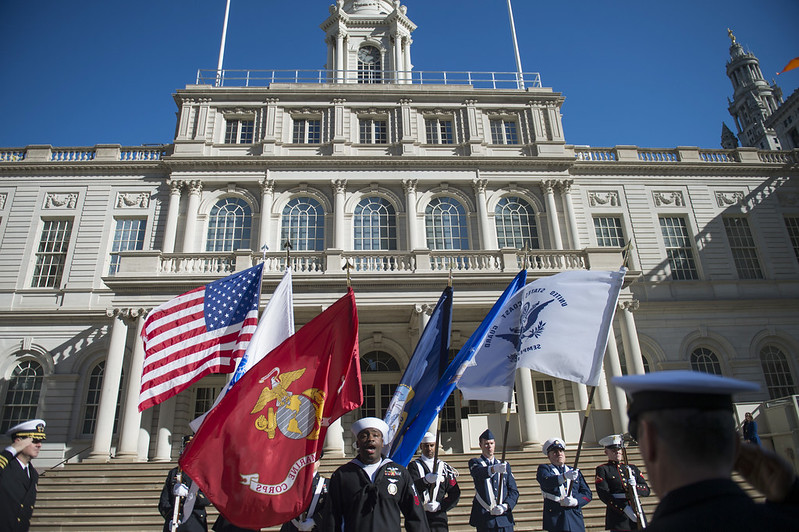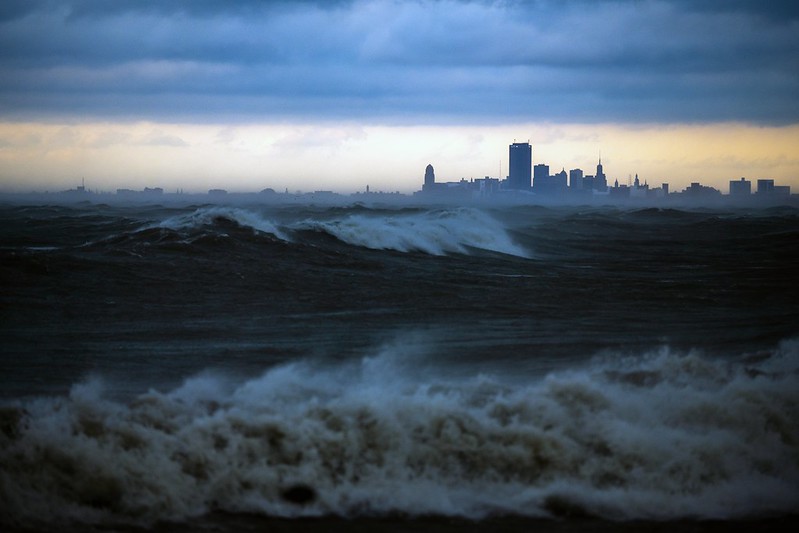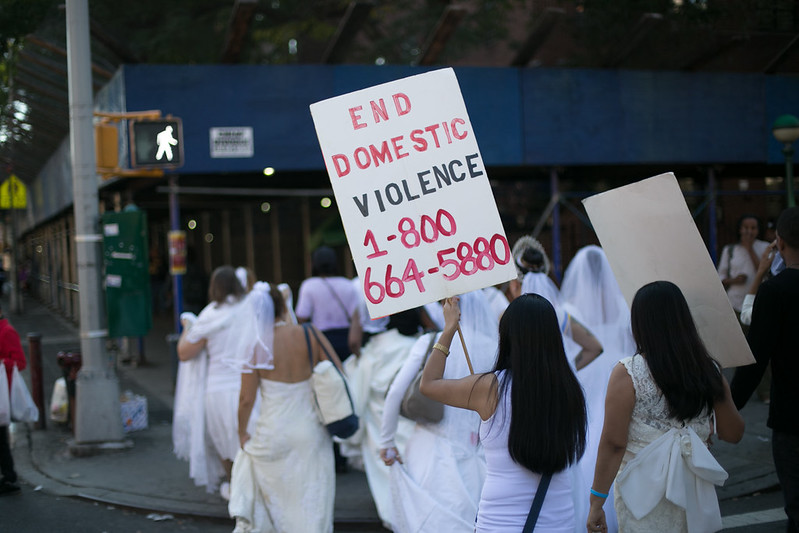Creating Career Pathways for Veterans in New York City Government

Veterans Day at City Hall (photo: Ed Reed/Mayoral Photography Office)
Democracy is an ideal that is central to who we are as Americans, but it’s an ideal that must be advanced and defended by each generation. While we are fortunate to have the freedom to choose our elected leaders and have a voice in our government, this freedom has been secured and defended by our military veterans. Their willingness to serve and sacrifice represents the highest calling in public service, and we owe these heroes an enormous debt of gratitude.
Over a quarter million veterans live in New York City and each has contributed to the peace and security we all enjoy. This Veterans Day, we express our sincerest thanks for their contributions. We thank them for being public servants and for answering the call of duty.
One small way the City of New York is acknowledging the service of our veterans is by creating career pathways for them to continue their service in city government. DCAS — the New York City Department of Citywide Administrative Services — offers fee waivers on civil service exams so that eligible veterans can take exams free of charge. To account for their unique skills and experience, veterans can also earn bonus points on those exams. Now, to further say thanks to our veterans and military families, we will be extending fee waivers for one exam to spouses of veterans.
At DCAS, public service is central to our mission. We manage the civil service system, the gateway to careers with the City of New York. As the largest local government employer in America, the career opportunities we offer to New Yorkers through civil service hiring helps us marry an individual’s interests with their passion for public service. Through the civil service system, applicants are afforded opportunities to demonstrate their fitness for jobs based on an objective assessment of their knowledge, skills, and abilities.
It is among our chief responsibilities to ensure that our civil service process develops a steady stream of qualified candidates who are ready to serve their city. When we think about the caliber of talent we need to lead our agencies, contribute to our city’s growth, and play a role in planning the future, there are few as worthy as our veterans. So, this Veterans Day as we celebrate their achievements and their sacrifice, we invite them to answer the call to service again – serving the City of New York. Our civil service pathways provide a wealth of career options, opportunities for advancement, and great benefits.
An effective government hinges upon having a workforce that is passionate about serving others. Our veterans embody this commitment, and we want to create pathways for veterans to join our ranks and make a difference in our city.
To learn more about upcoming civil service exams and careers with the City of New York, visit nyc.gov/dcas and nyc.gov/jobs.
***
Dawn M. Pinnock is the Commissioner of the NYC Department of Citywide Administrative Services (DCAS). On Twitter @NYCDCAS.
***
Have an op-ed idea or submission for Gotham Gazette? Email This email address is being protected from spambots. You need JavaScript enabled to view it.
Prop 1, the Environmental Bond Act, is a Once-in-a-Generation Investment Opportunity

On the waterfront (photo: Darren McGee/Governor's Office)
As New Yorkers head to the polls in this general election, which ends on Tuesday, November 8, there’s more than just candidates on the ballot. Voters across the state will decide on one ballot proposal, with three more for New York City voters only.
These ballot measures, or propositions, are yes/no questions on proposals to enact laws or constitutional amendments. Placed on the ballot for approval or rejection by the electorate, these major questions give enormous power to New York voters.
Question one is a statewide environmental proposal that, if approved, would have a monumental impact and ensure the state invests in equitable, long-term solutions to make communities healthier, safer, and more climate-resilient. The Clean Air, Clean Water, and Green Jobs Bond Act is the most significant environmental and climate opportunity in New York State in the last 30 years. It will enable us to access $4.2 billion worth of investments to protect clean drinking water, reduce flooding, restore natural resources, and reduce air pollution across the state.
The last environmental bond act in New York, all the way back in 1996, allocated $1.75 billion across the state. Then-Governor Pataki proposed the bond act and shepherded it through the Legislature by forming a bipartisan coalition that outweighed historical opposition. Notably, that funding led to forest preserve purchases in the Catskills and Adirondacks, conserved land and water across the state, and established New York’s first brownfield remediation program.
In March 2020, then-Governor Cuomo launched a campaign to pass legislation allowing voters to approve a $3 billion environmental bond act. In September 2021, Governor Kathy Hochul asked legislative leaders to amend the bond issue to include an additional $1 billion. Renamed the Clean Water, Clean Air, and Green Jobs Environmental Bond Act, it was increased to $4.2 billion when the Legislature gave it passage in April to advance the proposal to the voters this fall.
All New York voters should make sure to find the proposal(s) on their ballot and approve question 1, the environmental bond act.
“By putting forth bold plans to move New York into a safer, healthier, and more just future for all its residents, Governor Hochul has shown what can be done when a public official takes the existential crisis of climate change seriously,” said Peter Linderoth, Director of Water Quality, Save the Sound, in one of many supportive statements from long-time environmentalists and climate advocates across the state. The proposal is also supported by many leaders focused on environmental justice and in organized labor.
I’m a first-generation New Yorker, and I’ve lived in the East Bronx my entire life. Earlier this year, I ran for State Senate in New York’s 34th District, which unifies the coastal communities of Soundview, Throggs Neck, Pelham Bay, Country Club, and City Island in the Bronx with New Rochelle and The Pelhams in Westchester County. During my campaign, I was fortunate to connect with thousands of residents living in these shore communities of the East Bronx and Southeastern Westchester.
Across these neighborhoods, each with its own identity and unique characteristics, one thing was familiar — the impacts of climate change were evident. The flooding threats after a sudden and heavy storm continue to be a burden, especially in areas with sewage overflow problems. One rain shower could lead to severe aftereffects; damage to a home, a vehicle, and disrupted infrastructure is expected, in addition to the financial and health-related burdens residents are forced to endure.
When a summer storm would arrive, neighbors would rush to attempt to protect as much of their property as possible. Moving a car to higher ground and clearing basements of valuables were the first steps in preparing for the worst. As the rain comes down, our local infrastructure gets impacted as well; significant roadways and local streets would flood, as would driveways, building lobbies, and basements.
One Pelham resident shared with me that she had seen three of her cars get destroyed due to the power of these surging storms and flash floods. I often heard a popular refrain, “The streets turn into rivers,” as I would speak to voters door to door. A Bronx resident complained that flood insurance had become astronomical at their City Island home due to the regular and destructive flooding they continued to endure. Our sewage overflow systems are over one hundred years old, and rising sea levels exacerbate these concerns for coastal homeowners. Climate change impacts are felt regularly in the East Bronx and Southeastern Westchester.
In other areas of the state, the effects of the climate crisis had far more fatal results, such as when 11 died in Queens during the aftermath of Hurricane Ida due to the flooding of several basement apartments.
In July, Congressman Jamaal Bowman toured several towns affected by Hurricane Ida in Westchester County with the Army Corps of Engineers. The Congressman assessed the issues our Sound shore communities face, and in September, he shared that he had secured millions in federal funding for flood mitigation and flood prevention resources. Thanks to the Inflation Reduction Act, hundreds of billions of dollars will be invested in making our communities resilient and kickstarting the clean energy revolution.
Earlier this year, I believed legislation was the fastest way to address the climate crisis. In the New York State Legislature, the passage of bills like the Climate and Community Investment Act (CCIA), the Build Public Renewables Act, and the Living Shorelines Act are some of the most transformational policy proposals that could significantly impact our state. However, partisan politics and influence from special interests have made passing these bills difficult. The Clean Air, Clean Water, Green Jobs Bond Act uses capital to address critical climate initiatives while creating meaningful union jobs, and our citizenry has the final say! We need to invest in our safety and resiliency, and The Clean Air, Clean Water, Green Jobs Bond Act can help us do that.
Climate change is exposing long-term vulnerabilities in our region. Regardless of socioeconomic status, the many impacts of the climate crisis are projected to worsen — from drastic temperature and sea level changes to more common extreme weather events and shifting storm patterns. A child born today faces multiple and life-long health harms from climate change, growing up in a warmer world with risks of food shortages, infectious diseases, floods, and extreme heat. Climate change is already harming people’s health by increasing the number of extreme weather events and exacerbating air pollution. The air we breathe and the water we drink come at a price, and in communities with marginalized populations, our neighbors are likely to bear the brunt of this crisis.
We face some of the state’s most significant infrastructure and climate challenges. Storms like Hurricanes Sandy, Henri, Ida, and others have revealed flood risks across all five boroughs and lower Westchester. Flooding is affecting coastal communities more than ever, and it’s also become more of an inland problem given our challenges dealing with the most intense rainfalls.
Funding from the restoration, flood risk reduction, water quality improvement, and resilient infrastructure programs of the environmental bond act could jumpstart more coastal rehabilitation, shoreline restoration, green infrastructure, and sewer upgrade projects in flood-vulnerable communities, including environmental justice communities.
As New York faces a long and uncertain path toward economic recovery from the COVID-19 pandemic, the estimated economic impact of the proposed bond act includes support for $8.7 billion in project spending and over 84,000 jobs. These types of investments, working in conjunction with major federal funding initiatives, create good-paying local jobs and provide economic returns to local economies.
One of the most critical components of the bond act is the focus on ensuring that benefits reach environmental justice communities. The measure requires that New York spend 35% of the $4.2 billion on projects benefiting disadvantaged communities.
The bond act would enable multi-year investments across four major categories.
1. $650 million for water quality improvement and resilient infrastructure, focused on projects that protect clean water, such as stormwater infrastructure, drinking water, and wastewater infrastructure projects, pollution control, and lead service line replacements.
2. $1.5 billion for climate change mitigation, including investments in urban heat reduction, energy efficiency in buildings, renewable energy, and reducing air and water pollution.
3. $1.1 billion for environmental restoration and flood risk reduction. This funding will support voluntary buyouts in flood-prone areas; waterfront, wetland, and stream restoration; and dam removal and transportation infrastructure upgrades for flood reduction.
4. $650 million for open space land conservation and recreation. This funding will conserve forests, open space, and family farms and support upgrades to parks and other recreational infrastructure providing new and enhanced access to the outdoors.
Cities, towns, and communities across New York State will reap benefits from the Clean Air, Clean Water, and Green Jobs Bond Act. Every county in New York has declared disaster declarations due to flooding in the last ten years alone, and flooding continues to be the most common climate hazard in the state.
In each decade from the 1960s through the 1990s, New Yorkers approved bond acts to support environmental programs. The 2022 Clean Air, Clean Water, Green Jobs Bond Act is a once-in-a-generation opportunity to access $4.2 billion worth of investments to protect clean drinking water, reduce flooding, restore natural resources, and reduce air pollution across the state, while leveraging billions more coming from the federal government.
When you vote, vote yes on ballot question 1, the Clean Air, Clean Water, and Green Jobs Bond Act.
***
Christian Amato is an organizer, activist, and political strategist, from the Bronx, New York. He is the founder of Consense Strategies. On Twitter @AmatoForNY.
***
Have an op-ed idea or submission for Gotham Gazette? Email This email address is being protected from spambots. You need JavaScript enabled to view it.
We Need to Utilize All Proven Strategies to End Domestic Violence

A march against domestic violence (photo: William Alatriste/New York City Council)
Though Domestic Violence Awareness Month has ended, domestic violence is a tragedy that occurs every month, and every day. Uplifting the voices of survivors, recognizing the harm of abuse, and pursuing evidence-based solutions to break cycles of violence must be year-round priorities.
And sometimes, that evidence points in unconventional directions.
Our primary duty is to support survivors of domestic violence. The best way is with comprehensive, intersectional, and culturally-responsive crime victim services that help survivors escape future violence. This means providing safe and stable housing; emergency financial support on everything from food to clothing; and criminal legal system advocacy and guidance. Without these vital supports, we won’t solve this crisis.
Another strategy is to provide trauma-informed support to partners who commit abuse. This may seem like an unorthodox, even controversial, approach. But domestic violence is a unique offense. It involves people in deep, personal relationships with intense emotional connections.
Those who commit domestic violence reoffend at higher rates than virtually every other crime category. One study showed that anywhere from 20% to 33% of violators reoffend within months; another puts the frequency of recidivism in domestic abuse cases at more than 60% within months of a previous incident. And there are troubling signs that the pandemic has worsened domestic violence.
New approaches are urgently needed to break the cycle and actually curb the violent, destructive effects on survivors and families. That means using every strategy available.
Abusive partner intervention programs (APIPs) can reduce crime and provide long-term benefits to both parties involved in an abusive relationship and to the community as a whole – if done the right way. It’s not easy. Abusive partner interventions are challenging. But instead of giving up on these efforts to prevent recidivism, we must reinvigorate our commitment to proven methods that get results.
That means understanding that changing a person’s abusive behavior won’t take place if they are in a traumatized state. We must acknowledge and treat the trauma that so often triggers - and retriggers - violent acts.
This is what trauma-informed, culturally-responsive abusive partner interventions offer, which is dramatically more intensive than traditional APIP programs. The difference is that programs dig deep into both accountability and addressing root causes of behavior.
Importantly, this approach elevates survivor safety first and foremost and emphasizes abuser accountability. Clear protocols for compliance, strict schedules and guidelines, and crystal-clear coordination of services and support drive every part of this strategy. Centering survivors' voices and views in all aspects is a sacrosanct principle.
But understanding how past traumatic experiences can cause present and future behavior provides an invaluable way to prevent harm and violence. Tailored supports can help a person who commits intimate partner violence address and salve their trauma, and engage in the challenging work towards behavior change. Matching resources and designing programs to meet these needs is an innovative way to both identify and address the root causes of abusive behavior.
Providing services to those who cause harm does not excuse their crimes, or shift the burden of their offenses away from them. Abusers are responsible for their actions, and must be held accountable. Part of that accountability should include working to achieve real behavioral changes, which can only happen with trauma-informed engagement. In fact, many survivors want to see their partners receive this support, so cycles of violence can end and healthy relationships can begin.
When done the right way, trauma-informed interventions can help abusive partners develop care and compassion for survivors, do the work required to change their actions, and ultimately accept responsibility for the harm they’ve caused. This accountability is how we break cycles of violence.
We should invest in trauma-informed abusive partner interventions this month and every month, so that when Domestic Violence Awareness Month comes around next October, we can celebrate new, real reductions in this awful scourge.
***
Alison Diéguez is a Program Director at the CUNY Institute for State & Local Governance (ISLG), where she oversees ISLG’s work on gender-based violence and trauma. Nathaniel Tolbert, LCSW, is the Clinical Director of Manhattan APIP’s Urban Resource Institute and Director of URI’s Trauma Informed Abusive Partner Intervention Program and The Mayor’s Office to End Domestic and Gender Based Violence supported Respect and Responsibility Program. On Twitter @URI_NYC & @CUNYISLG.
***
Have an op-ed idea or submission for Gotham Gazette? Email This email address is being protected from spambots. You need JavaScript enabled to view it.




